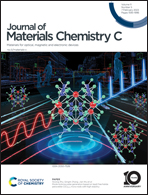Highly twisted bipolar molecules for efficient near-ultraviolet organic light-emitting diodes via a hybridized local and charge-transfer mechanism†
Abstract
Near ultraviolet (NUV) electroluminescence (EL) is very important but seldom reported for being short of short-wavelength emitters. Herein, we report two highly twisted terphenyl-based donor–acceptor molecules exhibiting excellent thermal and morphological stability and nearly quantitative NUV luminescence. Via a hybridized local and charge-transfer (HLCT) process, excellent NUV EL is achieved with a maximum external quantum efficiency of 6.97% and CIEx,y of (0.16, 0.06) in a nondoped OLED. The device shows excellent colour purity with a small full width at half maximum of 48 nm. Our research demonstrates that highly twisted structures can efficiently tune the luminescence wavelength of bipolar molecules to the NUV region and achieve high-performance NUV EL.

- This article is part of the themed collections: 2023 Journal of Materials Chemistry C HOT Papers and Photofunctional Materials and Transformations


 Please wait while we load your content...
Please wait while we load your content...